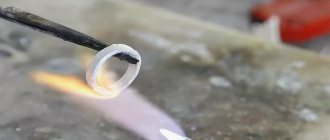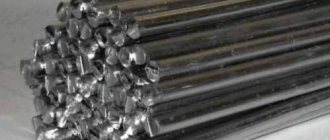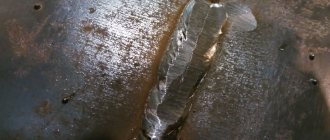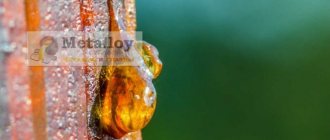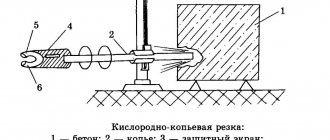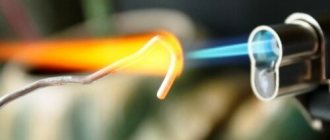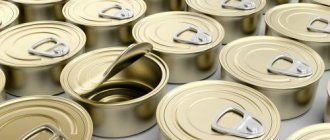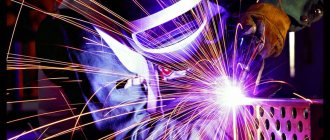Brass as a material has been known for quite a long time. Good physical and chemical properties have allowed it to become widespread. Brass parts also periodically develop defects (cracks, holes, breaks). These problems can be solved by soldering. In order for the result to be of high quality, it is necessary to have a good knowledge of the composition of brass, its physical and chemical characteristics, how to carry out soldering, what solders and fluxes are used for such work.
Basic information about brass
Brass can be double or multi-component in composition. It is always based on two metals: copper and zinc. In this alloy, zinc serves as the main alloying component. To impart different properties, various metals are added to its composition: tin, lead, manganese. Therefore, it is very important to know what composition of brass you have to work with. This is necessary to determine the conditions and specifics of soldering.
Modern brass is classified according to the following indicators:
Depending on the chemical composition:
- Two-component alloys. It contains only two metals, zinc and copper. The percentage of each may vary. This type is marked with the capital letter of the Russian alphabet “L” and a number. The number indicates what percentage of copper is contained in the alloy. For example, grade L85 - this alloy contains 85% copper and the remaining 15% is zinc.
- Multicomponent. They are also called special. Such alloys contain a large number of additives. They are marked with two capital letters and numbers. For example, brand LA77-2. She indicates that the composition includes 77% copper, 21% zinc and 2% aluminum. Therefore, very often special brasses get their name depending on the name of the alloying element with the highest percentage (aluminum, tin, nickel, manganese, and so on).
By degree and quality of processing:
- Deformable. These include brass in the form of wire, round tube, sheet and tape.
- Foundries. These are fittings, finished products made of brass.
According to the zinc content in the alloy:
- If the zinc content is in the range from 5 to 20%, then such an alloy is called red brass (tompak).
- If this percentage ranges from 21% to 36%, the brass is called yellow.
All brands of brass have similar properties. They are easy to process, have high anti-corrosion characteristics, and have sufficient strength. With a significant decrease in temperature, they retain their plasticity.
These properties have determined the wide range of uses of brass.
Criterias of choice
When choosing any composition for tinning copper parts or soldering wires, it is important to take into account a number of factors that will affect both the quality of work and the result obtained.
Among these criteria, first of all, pay attention to:
- types of elements to be connected, what material they are made of, their thickness and parameters of the surfaces to be connected;
- soldering method for which solder is selected - with a copper tip of a classic soldering iron, a hair dryer, a soldering station, etc.;
- permissible temperature regime - the melting temperature of the solder must be less than the melting temperature of the elements being connected;
- the presence of mechanical impact - determined by static or dynamic, possibly vibration;
- resistance to aggressive environments - for premature destruction of solder, its type must provide resistance to moisture, temperature, gases, dust and other factors affecting it during operation.
Most used brands
The most popular types are POS solders, they are based on lead and tin, marked POS-40, 60, 80, etc., here the numerical designation indicates the percentage of tin. They are produced, as a rule, in the form of soldering wire; depending on the percentage of the main components, they can be classified as either low-melting or high-melting grades.
Used for soldering copper, aluminum, brass, bronze and other metals:
- POS-90 – well suited for the food industry;
- POS-40 - used for pipes and parts made of brass, iron, etc.;
- POS-30 – in cable connections;
- POS-61 – for working with radio components.
Of the silver-containing grades, solders often found are PSr-15, 25.45, 65, 70; the number after the letter indicates the percentage of silver. This type covers both copper soldering in high-precision instruments and the medical field.
Rose alloy, also called POSV-50, is one of the solders with the lowest melting point - from 90 to 100 ° C. Used in jewelry, soldering printed circuit boards, for fuse links, etc.
Rice. 5. Alloy Rose
Application of brass
In addition to the listed positive properties, brass is a very durable and reliable alloy. Brass is used in the following areas:
- Manufacturing of pipeline fittings (adapters, valves, pipes).
- Plumbing fixtures (taps, mixers, washbasins)
- Furniture fittings (handles, latches, locks, decorative overlays).
- Production of electrical parts.
- Production of souvenirs.
- Production of tableware.
- Art casting.
- Jewelry production. Jewelers mainly use two-component alloys. It can be: yellow, red, green or golden brass.
Soldering brass pipes
Solders and fluxes: classification and selection methods
To obtain good soldering results, additives in the form of fluxes and various solders must be used.
Solder is a specific metal that, after melting, penetrates into metals prepared for soldering.
To achieve reliable contact, the brand of solder must have a melting point that will be significantly lower than the melting point of the brass itself. At the same time, it must have good adhesion to brass. Therefore, special solders are used for soldering brass.
Only as a last resort, if parts are soldered that do not bear much responsibility for the entire unit, and there are no high requirements for strength, ordinary tin-lead alloys are used.
Modern solders are classified as follows:
- By melting point. They are soft with a melting point reaching 400°C; semi-solid with the melting point of tin and solid. The melting point of hard solders exceeds 500 °C.
- By type of melting. Solders that melt completely or partially during the soldering process.
- According to the method of obtaining solder. We produce ready-made solders, and solders that are formed during the soldering process. This type of soldering is called contact reactive soldering.
- According to the list of chemical elements added to the composition. A fairly large number of such elements are used. From common metals zinc, tin, aluminum, to rare earth metals gallium, indium, palladium.
- According to solder manufacturing technology. They are: wire, stamped, rolled, cast crushed.
- By type of solder. They are produced in the form of wire, ready-made powder, in the form of tape and individual sheets, in the form of tablets and ready-to-use embedded parts.
- According to the method of flux formation. Solders are divided into two large categories: fluxed and so-called self-fluxing.
Solders, like brass, are marked with capital letters and numbers. By the marking you can determine which brass a particular solder is intended for. For example, if it is necessary to solder a part made of brass, in which there is a large percentage of copper, then it is proposed to use solder of the PSr12 or PSr72 brand. This solder contains a large percentage of silver. If there is a large percentage of zinc in brass, then it is advisable to use PSr40 solder. Therefore, in order to obtain a reliable connection after soldering, it is necessary to understand what loads are placed on the part being repaired. If the part is stationary and does not bear large vibration loads (for example, plumbing elements), you can safely use PMC solder. If it is necessary to ensure a strong connection, special hard solders are used, such as L-CuP6. This solder has a very high melting point - 730 ° C.
Solders for brass
To choose the right brand of solder, you can use the following method:
- Determine the melting temperature of the parts that are planned to be soldered.
- Determine the coefficient of thermal expansion. For brass that you plan to solder and the solder it should be very close.
- After soldering, the solder should not reduce the mechanical characteristics of the repaired part.
- The solder must form a galvanic couple with the main brass part. If this is not ensured, the corrosion process will quickly occur.
- The properties of the solder must comply with all technical and operational characteristics.
- The solder must ensure good wettability of the main part during the soldering process.
Read also: Level device and purpose
Flux is a special substance that allows you to prepare the surface of the metal, that is, remove the resulting oxide deposits, greasy and water stains from it. Without the use of flux, it is impossible to qualitatively solder a brass part. Fluxes are selected depending on the chemical composition of brass.
Experience shows that in order to qualitatively solder parts made from common brands of brass LS59 and L63, it is enough to have a flux consisting of zinc chloride dissolved in boric acid. If you need to solder brass, which contains lead and silicon (for example, LKS80 brand), then you need a flux containing fluorine and potassium compounds. They are also dissolved in boric acid, or borax. A similar flux for soldering can be prepared at home, using the appropriate elements in the required percentage.
Flux paste for soldering brass
Today, the industry offers ready-made fluxes for brass soldering. These include: Borax flux; fluxes PV-209 and PV-209X.
Features of the technology
Both in industrial and at home conditions, one has to face the need to connect products made of brass by soldering. This is due to the fact that this alloy of copper and zinc is actively used for the production of elements of plumbing and heating systems, as well as many other products.
The correct choice of flux is of great importance for obtaining a high-quality and reliable connection of brass products using soldering. To successfully carry out this process, ordinary flux, which contains alcohol and rosin, is not suitable. Due to the rather low activity of its constituent components, such a flux is not capable of dissolving the oxide film that is necessarily present on the surface of a brass product. That is why for soldering brass products it is necessary to use a more active flux, which is often used as zinc chloride.
Composition and use of acidic active pluses
Quite popular fluxes that are used for soldering brass in salt baths are borax and potassium fluoroborate. Such fluxes, the amount of which in the bath solution, as a rule, does not exceed 5%, ensure good flow of molten solder into the gap between the parts being connected.
The correct choice of solder wire is another important task that must be solved in order to obtain a high-quality connection of brass parts. For soldering brass products that will later be used in a gas environment, you can use popular types of solders based on silver and phosphorus copper alloys. Such solders are also ideal for joining brass products containing a significant amount of copper.
Brands and applications of solders
Brass itself is often used as solder, but it is necessary to ensure that the melting temperature of the filler wire does not exceed the same parameter of the parts being connected. In cases where it is necessary to form a connection of increased reliability using soldering, hard solders are used, which, when compared with soft-type filler materials, have higher strength.
Particular attention should be paid to the selection of solder and the soldering technology itself in cases where dissimilar materials need to be soldered together. It should be taken into account that such materials have different melting points and can also behave completely differently when heated. In particular, when intensely heated, zinc begins to evaporate from brass, which negatively affects both the decorative and strength characteristics of the joint being formed (it acquires a porous structure).
You can use a bucket of small pebbles as a fireproof substrate.
Certain technological methods allow one to avoid active evaporation of zinc from brass that is heated during soldering. The most effective of these techniques is the use of flux, which will perform a protective function, preventing the evaporation of zinc from the brass structure. The use of combined solder for soldering, which includes not only filler material, but also flux, is another effective way to avoid the evaporation of zinc from brass.
By choosing the right solder and soldering technology, you can even connect parts made of such a complex material as stainless steel at home. It should be borne in mind that brass solder is not suitable for soldering stainless steel parts; completely different materials are intended for this.
Soldering methods
The brass soldering process has certain specifics. The brass heats up and the hot zinc elements evaporate. At this moment, an oxide film is formed, which is quite difficult to remove from the surface of the part and thereby deteriorates the quality of soldering. Usually brass is soldered in two ways: using a soldering iron and using a special torch.
Soldering with a soldering iron
To successfully solder brass, a soldering iron must have a power of at least 1000 W. Such a soldering iron will provide the required heating temperature for the parts themselves and the solder. It should be 500ºС and above. Low temperature soldering of brass is only possible if it has a high percentage of copper content.
Soldering brass with a soldering iron
The most convenient way is to solder using a soldering station, which has an adjustable soldering iron tip temperature. This adjustment allows you to set the optimal heating mode. The point is that during soldering it is necessary to avoid unnecessary overheating of the soldering area. The optimal temperature for heating the soldering iron tip is up to 350°C.
Soldering using a gas torch
The task of soldering brass can be solved using a small torch. The brass part is placed on any heat-resistant material; it must withstand high temperatures. Asbestos plates are used for these purposes.
Soldering brass with a gas torch
The parts that need to be soldered are placed on this plate and aligned with each other. Preparation for soldering is the same as when soldering with a soldering iron. Next, the solder is cut into small metal chips or shavings and sprinkled on the joint of the parts. Then adjust the size of the burner flame and bring it to the soldering zone.
First, it is necessary to slightly heat the soldering area so that the solder sticks to the surface of the brass. After this, complete heating is started until a characteristic red color appears on the surface of the brass. With a correctly adjusted burner, the temperature in the soldering zone reaches 700 °C. After cooling, it is necessary to remove sagging and flux residues.
So, in order to get good results when soldering brass parts, you need to choose the right solder. Monitor the cleanliness of the soldering iron rod and the degree of its heating. You should never start soldering if the soldering iron has not reached the required temperature. Carefully prepare the surfaces of the brass part that you plan to solder (wipe off dirt and dust and degrease). Carefully monitor the degree of heating of the working area of the parts being soldered.
If you find an error, please select a piece of text and press Ctrl+Enter.
Brass is widely used in everyday life, and the question of how to solder brass is very important for some. Repairing many home appliances depends on what you use to solder the metal. This process is noticeably different from joining other metals. It has a number of specific features and causes certain difficulties. However, if certain conditions are met, then soldering will be within the capabilities of any person.
Brass is widely used in everyday life, and when brass products break, the question arises of what to solder it with.
Specifics of working with brass
The brass solders themselves outwardly resemble an ordinary wire rod made from special refractory alloys.
Provided you master all the features of the process of joining metals, as well as having the appropriate consumables, mastering the technique of brass soldering at home is a completely doable task.
In a domestic environment, a conventional gas burner powered by a propane cylinder can be used for these purposes. You won't be able to melt brass material with a soldering iron.
However, before starting work, you should carefully study all the features of the brass soldering process.
The specificity of soldering is the need to use a consumable material whose melting point is slightly lower than the same indicator for the metal products being joined.
If this condition is met, which is mandatory for the formation of a reliable permanent connection, anyone will be able to solder metals of dissimilar structures.
During the work process, soldering solder, cut to the state of small chips, is poured into the gap between the workpieces. And only after this it will be possible to start heating using a gas burner (in its absence, you can use a blowtorch).
It is not allowed to confuse metal soldering with a welding process similar in technique, in which both jointed workpieces are subject to melting.
A schematic representation of the technological process, in which brass wire is used as a consumable material, can be found in the photo.
A direct consequence of the considered features of soldering with brass or tin solder is the ability to connect small-sized metal parts that will not overheat significantly during processing.
The technologies for soldering steel workpieces are based on the same principle; when working with them, special active additives (fluxes) are added to the brass solder. The latter significantly simplify the process of joining products by increasing the temperature in the working area and better spreading of the melt.
Features of soldering copper alloys
In everyday life, various parts are often used in which brass and bronze are used. These copper alloys are very similar in appearance, but have different compositions and their own characteristics. Brass is a copper-zinc alloy with the addition of tin, aluminum and other metals. Bronze is an alloy of copper with tin, aluminum, lead and other substances. Brass, to which tin is added, approaches the composition of bronze, but still its basis is zinc.
Materials and tools for soldering brass products.
Soldering brass has its own inherent difficulties. When exposed to heat, zinc actively evaporates from the alloy, forming a dense film of zinc oxide and copper. The zinc oxide film is destroyed with great difficulty, and its formation occurs quite quickly when the zinc content in brass is more than 15%. Rosin, even in combination with alcohol, cannot cope with such a film, which requires the use of special fluxes.
If you use tin-lead solder when soldering brass, the connection has low mechanical strength. Thus, where brass is soldered with tin-lead solder, its strength is 1.6 times less than that of copper. This is due to the appearance of pores in the soldered seam due to the evaporation of zinc.
Methods for soldering bronze depend on its composition. Tin and nickel bronzes are easily soldered with tin-lead solders. When soldering aluminum and beryllium bronzes, difficultly soluble films arise, which necessitates the use of special solders and fluxes.
Fluxes for metal soldering
To solder brass you will need borax, a special flux.
Fluxes are designed to remove films from the surface of metals being soldered and protect against the formation of new films in the soldering zone. While rosin is sufficient for joining copper, brass requires a different, much more aggressive flux. The flux composition required for different brasses is different, which is caused by the introduction of certain metals into the brass composition. For common brasses such as LS59 and L63, the use of zinc chloride with a small content of boric acid is sufficient. When soldering brass with additions of lead and silicon, for example, brass type LKS80, a flux based on a compound of potassium with fluorine and boron or based on borax is recommended.
At home, you can make the following flux, which is suitable for most brass. It is necessary to prepare 20 g of powdered borax and 20 g of powdered boric acid. Dry powders are mixed well and poured with 200 ml of water. The mixture is then boiled and cooled.
Read also: How to insert a drill into a Makita hammer drill
Of the ready-made compositions as fluxes for brass, we can recommend: domestic ones - “Bura” flux; fluxes PV-209 and PV-209X. Of the imported ones, German-made fluxes should be noted: Chemet FLISIL-NS-Pulver and Chemet FLISIL-NS-Paste flux paste.
Bronze can be soldered using a flux made from chloride salts (for example, zinc) with the addition of hydrochloric acid. If soldering is performed at high temperatures, it is better to use boric acid in combination with chlorates and fluorides. To connect aluminum and manganese bronzes, you will have to use active fluxes made from orthophosphoric or hydrofluoric acid. Of the readily available agents, orthophosphoric acid is usually used.
Solder for brass
Solder for brass should be copper-phosphorus. solders
Solder is a metal that, in a molten state, is introduced into the metals being soldered and, after cooling, joins them. Consequently, it must have a melting point significantly lower than the melting point of brass and at the same time have good adhesion to it, being in the form of a melt. Conventional alloys of tin and lead should be used in brasses only when connecting non-critical parts where there are no requirements for mechanical strength and appearance.
The composition of the solder used depends on the type of brass. If the copper component predominates in brass, then you can use silver solders from PSr12 to PSr72, solders containing brass from PMC36 to PMC54 and copper-phosphorus solders. If the zinc content predominates, silver solder of at least PSr40 should be used. The use of phosphorous compounds leads to a noticeable decrease in the mechanical strength of the joint due to the formation of fragile zinc phosphorus compounds. Cheaper brass-based solders such as PMC can only be used in parts that do not experience vibration and shock. When joining with silver and phosphorous solders, brass dissolves quite strongly, which should be taken into account and reduce the time of soldering and heating of metals.
To repair and join permanently fixed parts (for example, radiators or pipes), special hard solders with a complex composition are often used. Good results are shown by L-CuP6 type solder, which has a melting point of about 730°C.
Main characteristics of aluminum rods
Rods made of aluminum are presented in the form of individual barrels, coils or solid semi-finished products. If we talk about the cross-section of the rod, they come with a square, hexagonal and round cross-section.
When performing each type of work, a rod of the appropriate cross-section is used. The classification of soldering rods is determined by increased, high and normal accuracy.
Aluminum rods are produced hardened, artificially or naturally aged, and also soft. Aluminum rods are found with a one-sided cross-section, forged, rolled, cast, drawn and pressed, rolled into special coils.
Most often, D16T alloy is used for aluminum rods. This is explained by the fact that it has good strength properties, is lightweight and is resistant to use in aggressive environments. Among other things, it also does not rust during use.
With the help of soldering, it is possible to obtain high-quality connections of dissimilar materials. If the need arises, the solder joint can always be disconnected and reconnected, which cannot be said directly about welding.
The only downside of soldering is that such connections cannot boast of high mechanical strength. Therefore, this option is not suitable in all cases.
Making your own solder
Silver solders are also suitable for packing brass.
In order to solve the problem of soldering brass, you should prepare the necessary solder with your own hands. Silver solder is most suitable for all brasses; it should be prepared. Melting of metals must be carried out in a crucible that can withstand significant thermal influences. Most simply, such a crucible is made from contact carbon elements for trolleybuses. Burnt elements are quite accessible and can be useful for a crucible. A recess measuring approximately 2x2 cm is made in such a graphite element, and a groove about 5 mm wide is machined into the recess (to facilitate removal of solder).
Solder requires silver and copper in a 2:1 ratio. The required amount of metal is measured and lowered into the crucible. Using a gas burner, metals are melted in a crucible. To simplify the melting process, the metals should first be crushed as much as possible. The melt is mixed with a steel or ceramic (porcelain) rod. After cooling, such an alloy can be used as solder.
Methods for brazing carbide inserts
Soldering of carbide plates is carried out in flame, gas or electric muffle furnaces Source youtube.com
Soldering of cutters consists of heating the plate itself and melting the solder, which can be done in different ways using:
- High frequency currents.
- Plasma gas or muffle furnaces.
- Contact welding.
- Oxy-acetylene torch.
Recommendation: for silver solders, high-titanium alloys T60K6 or T30K4 should be used, which reduce the thermal stress that appears during cooling.
Soldering with a soldering iron
A soldering iron for soldering brass must have a power of at least 100 W.
A sufficiently high quality of connection using low-temperature soldering is achieved when soldering brass and copper or when soldering brass with a predominant copper content. In this case, it is enough to use a soldering iron with a power of 100 W. Soldering or phosphoric acid can be used as a flux. Before soldering, it is necessary to carefully treat the surface of the brass to remove the oxide film and degrease the surface. Tin-lead solder not lower than POS60 is used as solder. Soldering is carried out when the metal soldering zone is well heated with a soldering iron.
You can solder brass with a soldering iron and use silver solders no lower than PSr40. To do this, you will have to arm yourself with a powerful soldering iron (0.5-1 kW). As a flux, it is necessary to use concentrated orthophosphoric acid or borax-based flux. The heating temperature of the soldering zone should be no lower than 500ºС. Before soldering, special attention should be paid to thoroughly treating the surface with flux. The treatment should be carried out immediately before applying a heated soldering iron with solder. In this way, you can melt defects in solid brass products (for example, radiators).
Soldering with a torch
Scheme for welding brass with a semi-automatic torch.
To solve the problem of soldering brass of any brand, you can use a gas torch. The process of such soldering is as follows. Soldering (heating of metals) is carried out on a heat-resistant material. It is best to use asbestos plate. The parts to be connected are placed on an asbestos base and aligned with each other. The surface of the metals in the joint area is thoroughly wiped with borax-based flux (home-made).
Silver solder is cut into small shavings and sprinkled on top of the metals being joined in small quantities. An adjusted flame of a gas burner is introduced into the soldering zone. Warming up is done in stages.
First, the area is lightly heated so that the solder adheres to the surface of the metals.
Then the main heating is carried out until redness appears on the brass. At this time, the solder should fill the gap between the parts and spread evenly over the surface. The temperature in the soldering zone during this period reaches 700-750°C. The burner turns off. After cooling, you should get a reliable seam with a color not much different from brass. The joint must be washed to remove flux residues.
Soldering of carbide plates. Instructions
General provisions.
These instructions apply to soldering cutters on HDTV installations: VCHI-25, VChG-60, LP3-2-67M and other similar ones.
Preparation of carbide plates and cutter holder bodies for soldering.
- All operations for pre-processing carbide plates should be carried out before cleaning the supporting surfaces.
- Sharp corners on hard alloy plates and pressing defects: swelling, chipping (GOST 2209-90) must be removed by chamfering or cleaning.
- Plates that are warped must be ground.
- The surfaces to be soldered must be cleaned and freed from oxides by grinding on a diamond wheel. The gap between cleaning and soldering should not exceed 2…3 days.
- Cracks, chips and blockages on hard alloy plates are not allowed.
- The surfaces of cutter holders subjected to soldering should not have nicks, cracks, burrs or blockages that would interfere with the tight fit of the carbide plates. Casting pores, cavities and underfills in the soldering area are not allowed. Toolholders with such defects are rejected.
- Carbide inserts and holder bodies must be free of rust, oxides, oils and other contaminants.
- When performing soldering with compensating spacers, the holder sockets must be lowered by 0.3...0.8 mm.
Quality control of preparation of carbide inserts and cutter holders.
- The cleanliness of the soldered surfaces of hard alloy plates must be within class 6...8 (1.6v...0.4v).
- The cleanliness of the soldered surfaces of the cutter holder must be within class 4…6 (6.3v…1.6v).
- All plates supplied for soldering must comply with GOST 25393-90, GOST 25426-90, GOST 2209-90, GOST 17163-90, GOST 20312-90, GOST 22771-90, GOST 9391-80 in terms of microstructure and have a durability coefficient of at least specified in the technical specifications of the drawing.
- The permissible gap between the plate and the body is 0.08...0.12 mm.
- Deviation from straightness should not exceed ± 0.05 mm.
- Permissible warping of plates <0.04 mm.
- The maximum overhang of carbide inserts should not exceed 2.0 mm.
- Control of the mutual fit of the carbide plates and the grooves of the holders is carried out on 1...3% of the tool units from the batch, but not less than 5 pieces. Inspection visually or using a probe.
Preparing solder and flux for soldering.
- For soldering cutters, use: solder ANMts-06-4-2 TU 48-21-87-80 of the following chemical composition: Cu – 64.5%, Ni – 4.5%, Mn – 2.0%, Zn – the rest. Solder melting temperature is 1035...1060? C. Soldering temperature 1100...1180? C.
- brass solder MNMts 68-4-2 TU 48-08-476-71 of the following chemical composition: Cu – base, Ni – 3...4%, Mn – 1.5...2.5%, Al – 0.5...0, 6%. The melting temperature of solder is 930...960? C. Soldering temperature 990...1060? C.
Tool soldering.
- Preparation for soldering. Parts should be supplied for soldering according to the accompanying documents, executed by inspection, indicating the tool code, its quantity, grade of material, TT drawing and cutter sketch indicating the position of the carbide plate relative to the holder body. Before soldering, prepare the thermal carts for operation, the sand temperature should be within 150...300? C, the sand layer should be at least 100...150 mm. Monitor the temperature of the sand in thermal carts with a thermometer, immersion depth of at least 40 mm. The temperature of the sand in the thermocouple is recorded using an XA thermocouple.
- The selection of an inductor is carried out under the condition of installing a soldered cutter with a gap between the inductor and the holder within 5...15 mm, no more, or under the condition of installing two cutters with a gap between the cutters of no more than 0.5 mm, between the inductor and the holder of 5...15 mm, no more. Install the rotary table at the slot inductor. Select the current strength and voltage using test cutters. The heating time at a given current and voltage is adjusted by the table rotation speed and the gap between the inductor and the cutter, which should be within 5...15 mm. During the passage of the cutter in the inductor, the solder must be melted.
- The pyrometrist prepares the KSP-3 device for use.
- Adjustment of the HDTV installation by circuit voltage, anode and grid current is carried out during test soldering of 2...5 cutters from the batch (code) of cutters. The received data is recorded in a journal with a record of codes and dates of soldering with the signature of the controller.
- If necessary, combine soldering with hardening with compressed air. Open the air system, blow out the supply hoses for 5...10 minutes to remove moisture, set the required air flow using the PC5 flow meter. Write the data to the log. Temper the support part of the cutter holder in a special trough with running water, adjust the stand for the cutter so that the water level does not reach the carbide plate 4...8 mm. Select the immersion depth to obtain the required hardness.
- On the thermogram of the KSP-3 device, record the test soldering with the code written down, indicating the name of the thermist and controller. The entries in the journal and on the thermograph must match.
- Before soldering, ensure the quality of fit of the holders and carbide plates in accordance with paragraph 3. Blow off the holders and carbide plates with sand, rinse in hot water at T = 80...90 C and dry in the open air or under a stream of compressed air.
- Cool cutters that are not subject to hardening after soldering for 10...40 seconds in air, depending on the cross-section of the holder, and lower them into a heat transfer cart with sand. Maintain the temperature in the thermal cart within 150...300 C while filling it with cutters. After filling, turn off the cart. Cool the cutters in the thermal cart to a temperature of 80 C in accordance with the readings of the device, then remove them and cool them in air to ambient temperature.
Hydrosandblasting
- All cutters that have undergone heat treatment should be sent to the hydrosandblasting department.
- Each cutter must be blown individually by hand on a soft lining (rubber mat) to prevent breakage of the carbide plates.
- Rinse the blown incisors in hot water at a temperature of at least 80 C and dip into the GZh1 preservative solution.
Removing excess solder.
- Solder deposits present on soldered cutters can be removed mechanically (by cleaning).
Quality control of cutters after soldering and heat treatment.
- Quality control of the soldered tool is carried out after blowing.
- Adjustment and soldering of test cutters should be carried out on 2...5 pieces, depending on the size of the batch and their compliance with the TT drawing.
- There should be no excess solder or flux on the surface of the cutters in the form of sagging or smudges. It is allowed to tin the body plates with a thin uniform layer of solder no more than 0.5 mm.
- The solder layer under the carbide plate should be within 0.05...0.35 mm. In the seam around the perimeter and corners, isolated places without soldering (pores) are allowed. On the side supporting surfaces of the carbide insert, the total length of the gaps should not exceed 50% of the solder seam. Breaks in the solder seam between the supporting surfaces of the carbide insert and the holder should not exceed 10% of the visible length of the solder seam on through and scoring cutters and 5% on slotting and parting cutters. GOST 5686-61 (ST SEV 1165-78). Solder breaks under the main cutting edge are not allowed.
- The quality control of the soldered seam should be carried out visually on 2…5 broken cutters (beat off the carbide plate before opening the solder) depending on the batch size. It is allowed to beat a carbide plate on an arbitrarily selected cutter during the batch soldering process. Soldering is suitable if there are defects (oxidation, flux residues and unsoldered joints) not exceeding 10% of the total area of the soldered seam.
- Check the absence of chips and cracks in the hard alloy using a magnifying glass with 4…10x magnification.
- Control of the hardness of the holder in accordance with the technical specifications of the drawing should be carried out at a distance of 3...10 mm from the soldered seam, depending on the design and configuration that allows for control; hardness measurements should be carried out on cut samples with a ground surface.
- Permissible displacement of the carbide insert relative to the supporting part of the holder is ±0.5 mm.
- Final quality control is carried out after sharpening using the LUM-1OV method in accordance with clause 8.4. Cracks and chips on carbide inserts and holders are not allowed. The assessment of soldering defects is carried out visually by the appearance of the soldered seam on broken cutters (see paragraph 8.5.). The passage of cutters with defects is carried out with the permission of the workshop quality commission with an entry in the journal. After sharpening and detection of defects on the LYUM-1OV, resoldering of the cutters is carried out according to the accompanying document with the permission of the workshop commission with an entry in the journal and a spacer on the holder with the distinctive mark “P”. The permissible number of re-solderings is no more than 2 times.
The cutters used for quality control should be written off according to the report
Necessary tool
If you have decided what to solder with, then you should also decide what to cook. When soldering brass, you will need the following tools and accessories:
- soldering iron with a power of 100 W and 0.5-1 kW;
- gas burner complete with gas cylinder;
- crucible;
- scales;
- vice;
- knife;
- scissors;
- file;
- pliers;
- clamp;
- sandpaper;
- brush;
- brush.
Brass is very often used in various household devices, so when they break, the question arises of how to solder brass. Such soldering is quite possible, but requires certain conditions and rules to be met.
Brass soldering is used when you need to connect small metal parts. For example, it is used in artistic forging when assembling a general composition or in a home workshop. In this case, ornamental steel with a flat or square cross-section is most suitable, where the contact area is larger than that of round rods. In addition to the fact that brass can be used as a solder to solder parts made from this material, there are also some tricks to get a high-quality seam.
Scheme of soldering metals with brass using a gas torch.
How to use brass solder
Before soldering can begin, the product must be assembled. To do this, individual parts are fastened together using metal wire (bindra). When the preparation is completed, everything is placed together in a gorg, where heating occurs until the metal is red-hot. Extreme care must be taken when laying. A poker is used to clear space in the coals for the product; the fuel remains on the grate in a fairly large and even layer. When working with coal, it is important to ensure that it does not fall on the forge, even in the smallest pieces. The blowing of the forge should not be strong in order to obtain uniform calcination.
Read also: How to test a transformer for functionality
As a rule, borax acts as a flux. Before application, it is moistened with water over the entire surface, after which soldering begins. Leaving the flux in place, take a rod of brass and run it where the connections should be. At this moment, the flame in the forge changes its color to green. During the soldering process, the product blank should not move or move from its original location. This will help to avoid accidental displacement of parts relative to each other, so as not to spoil the seam, both from the point of view of visual appeal and the reliability of the seam.
Table of composition and application of solders.
If the composition contains many elements, then welding occurs differently. In those places where soldering will be done, from the very beginning the brass is laid out in pieces, in the expectation that when heated it will begin to spread, as a result of which the parts will be held together.
Brass can be used in individual pieces, shavings or sawdust, sprinkled in the welding areas. At the same time, they must meet the requirements of purity so that there are no impurities or foreign inclusions. Iron filings and other small metal parts are removed using a magnet.
To solder smaller parts, clay with salt added to it is used as a fastening material. But when assembling individual parts, the wire used for fastening is not iron, but brass. After this, the product is sprinkled with borax, coated with clay and carefully placed on a sheet of metal, which is sent to the forge. You also need to blow lightly; the clay should be heated evenly. After it dries, the air supply becomes more active. Clay that has begun to crack indicates that the parts are securely fastened together. Soldering of individual parts occurs using brass wire, which at this point melts and holds the parts together. At the end of the process, the forge is turned off, the finished forged product must cool down. The final stage is to remove clay and flux, and remove excess solder with a file.
Soldering brass with a gas torch
Quite often craftsmen wonder how to solder brass. If it is necessary to fasten brass parts, a slightly different technology is used. Brass parts lend themselves well to processing, soldering, after which they are specially blackened. Many people use tin as solder in this case: it is available in almost every workshop and is easily melted with a regular soldering iron.
Diagram of a gas burner.
The method is quite simple, but has significant disadvantages:
- the finished seam stands out against the background of brass with a white color, while it is not immediately thin and neat for everyone;
- the seam turns out to be fragile and cannot withstand bending;
- During the blackening process, both metals behave differently, the tin weld is different from the brass part in color, they have different shades.
Soldering with a gas torch using special solder for brass and flux will help to avoid such problems. As a result, the weld is difficult to distinguish from the base metal of the product by color; it is highly durable, and in its chemical composition it is much more similar to brass than tin.
Working with brass is more likely to be welding due to the high temperatures for which an ordinary soldering iron is not suitable, but it is commonly called soldering mainly due to the fact that solder is used.
First of all, the solder is prepared.
It consists of silver and copper in a ratio of 2:1, which must be fused together on a gas burner. Copper is more refractory, so you can start with it and then pour in the molten silver and mix with a wire bent into a hook. The finished solder is cooled, rolled out in a roller or on an anvil, and then cut into pieces. There is a more accessible way: using a coarse file, go over the casting to form chips.
Next, flux is prepared. Powdered borax is mixed with powdered boric acid in equal parts of 20 g, after which it is poured with a glass of water. In order for the ingredients to dissolve well, it all needs to be boiled. As one of the options for use, it can be recommended to evaporate the water, calcinate the solid ready-made flux and grind it into powder, which is subsequently mixed with solder.
Conditions and scope of soldering
Before understanding the question of how to solder brass, you should thoroughly study all the features of such a technological process. When performing soldering, which is one of the methods for producing permanent connections, molten solder is introduced into the gap located between the parts being connected, which acts as a fastening element.
An important condition for soldering is that the solder, which is melted using a gas burner, must melt at a lower temperature than the material used to make the parts being joined. This technology (in some cases it is the only possible way to obtain a permanent connection) allows even dissimilar metals to be reliably soldered together.
Brass soldering diagram using a gas torch
It is completely wrong to compare soldering with a technological process such as welding, which assumes that not only the special solder wire will melt, but also the metal of the parts being connected. It is precisely due to the fact that when performing soldering, the solder is exposed to the main temperature effect, the characteristics of the parts being connected and their integrity remain unchanged. This feature allows this technique to be successfully used for joining metal parts that are even very small in size.
Meanwhile, it should be borne in mind that for soldering, softer materials are used as solder when compared with those used to form the weld. This leads to the fact that connections created by soldering are initially less strong and reliable than welded seams. And in cases where brass is soldered, zinc evaporates from the solder during intense heating, which leads to porosity of the formed seam. Such metal porosity significantly impairs the quality and reliability of the connection. When soldering parts made of brass, their relative position is also of great importance. It is better to connect such parts not end-to-end, but overlapping.
For soldering at home, you can get by with a manual gas torch with a 1.8 kW cylinder
Metal soldering as a technology that makes it possible to obtain permanent connections occupies one of the leading positions, second only to welding in popularity. This technology is practically indispensable in the electronics industry, where it is used to create electrically conductive connections between elements of various instruments and devices. It is with the help of soldering that wires are most often connected and extended, through which electric current will subsequently pass.
If we talk about the most common areas of application of soldering, then these include:
- formation of hermetic connections of pipes made of copper and its alloys, including brass (such pipes are used primarily for completing refrigeration and heat exchange units);
- fastening carbide inserts to the bearing part of the cutting tool;
- connection between parts that differ significantly in thickness.
The photo shows the result of soldering a brass tube and a jet. We used P14 fluxed solder and an imported pure propane burner.
Using soldering equipment and solder, they also perform a technological operation such as tinning, which allows you to create a reliable anti-corrosion coating on metal surfaces.
Depending on the type of solder used for soldering, it can be high or low temperature. The use of a more refractory material when soldering allows you to create connections that can be operated at higher temperatures. However, this is associated with some difficulties, which are associated with the need to use special equipment that allows you to melt the solder. The use of such an alloy, in particular, is quite problematic at home, where a conventional blowtorch is most often used for soldering.
